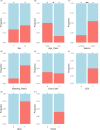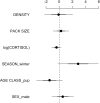Evaluating noninvasive methods for estimating cestode prevalence in a wild carnivore population
- PMID: 36378663
- PMCID: PMC9665365
- DOI: 10.1371/journal.pone.0277420
Evaluating noninvasive methods for estimating cestode prevalence in a wild carnivore population
Abstract
Helminth infections are cryptic and can be difficult to study in wildlife species. Helminth research in wildlife hosts has historically required invasive animal handling and necropsy, while results from noninvasive parasite research, like scat analysis, may not be possible at the helminth species or individual host levels. To increase the utility of noninvasive sampling, individual hosts can be identified by applying molecular methods. This allows for longitudinal sampling of known hosts and can be paired with individual-level covariates. Here we evaluate a combination of methods and existing long-term monitoring data to identify patterns of cestode infections in gray wolves in Yellowstone National Park. Our goals were: (1) Identify the species and apparent prevalence of cestodes infecting Yellowstone wolves; (2) Assess the relationships between wolf biological and social characteristics and cestode infections; (3) Examine how wolf samples were affected by environmental conditions with respect to the success of individual genotyping. We collected over 200 wolf scats from 2018-2020 and conducted laboratory analyses including individual wolf genotyping, sex identification, cestode identification, and fecal glucocorticoid measurements. Wolf genotyping success rate was 45%, which was higher in the winter but decreased with higher precipitation and as more time elapsed between scat deposit and collection. One cestode species was detected in 28% of all fecal samples, and 38% of known individuals. The most common infection was Echinococcus granulosus sensu lato (primarily E. canadensis). Adult wolves had 4x greater odds of having a cestode infection than pups, as well as wolves sampled in the winter. Our methods provide an alternative approach to estimate cestode prevalence and to linking parasites to known individuals in a wild host system, but may be most useful when employed in existing study systems and when field collections are designed to minimize the time between fecal deposition and collection.
Copyright: This is an open access article, free of all copyright, and may be freely reproduced, distributed, transmitted, modified, built upon, or otherwise used by anyone for any lawful purpose. The work is made available under the Creative Commons CC0 public domain dedication.
Conflict of interest statement
The authors have declared that no competing interests exist.
Figures




References
-
- Tompkins DM, Dobson AP, Arneberg P, Begon ME, Cattadori IM, Greenman JV, et al. Parasites and host population dynamics. In: Hudson PJ, Rizzoli A, Grenfell BT, Heesterbeek H, Dobson AP, editors. The ecology of wildlife diseases. Oxford University Press Oxford, UK; 2002. pp. 45–62.
Publication types
MeSH terms
LinkOut - more resources
Full Text Sources

